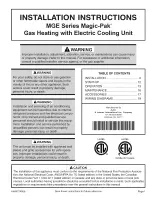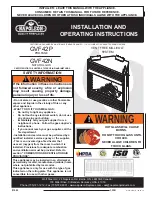
T/P Valve Discharge pipe:
1. Must NOT be smaller in diameter than the outlet
diameter of the valve, or have any reducing couplings.
2. Must NOT be plugged or blocked.
3. Must be made of suitable material for hot water.
4. Must not be over 15’ in length.
5. Must not have more than two elbows.
6. Must terminate at an adequate drain.
7. Must not have a shut off valve between relief valve and
tank or relief valve and termination of discharge.
CLOSED SYSTEM THERMAL EXPANSION: Periodic discharge of the
T/P relief valve or failure of the element gasket may be due to
thermal expansion in a closed water supply system. The
water utility supply meter may contain a check valve, backflow
preventer or water pressure reducing valve which will create a
closed water system. During the heating cycle of the water
heater, the heated water expands causing pressure inside the
water heater to increase. The T/P relief valve may discharge hot
water under these conditions which results in a loss of energy
and a build up of lime on the relief valve seat.
To prevent this from happening, there are two recommendations:
1. Install a diaphragm-type domestic hot water expansion
tank (suitable for potable water) on the cold water
supply line. The expansion tank must have a minimum
capacity of 1.5 U.S. gallons for every 50 gallons of
stored water.
2. Install a 125 PSI pressure relief valve in the cold
water supply line. Make sure the discharge of this valve
is directed to an open drain and protected from
freezing. Contact your local water utility or plumbing
inspector for information on how to control this
situation. Never plug the outlet of the relief valve.
Page 8






































